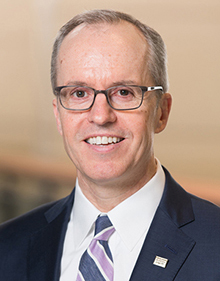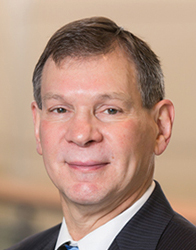The RSNA Virtual Meeting is Virtually Unmatched
Since 2011, the rapidly growing Virtual Meeting has emerged as model of success


When RSNA — which hosts the world’s largest annual medical meeting — took its first steps into the virtual world, the Society started small.
Launched in 2011, the first virtual meeting offered simultaneously with the onsite RSNA annual meeting at McCormick Place, Chicago, included nine sessions with accompanying slides and videos of speakers, as well as an online technical exhibit. Over the years, the virtual meeting has expanded dramatically in terms of content and evolved significantly based on member input.
“The virtual meeting started out as an experiment: Could we deliver the same high-quality content virtually to those unable to attend the onsite meeting as we do those who attend the RSNA annual meeting in person?” said Curtis Langlotz, MD, PhD, professor of radiology and biomedical informatics at Stanford University, and RSNA Board of Directors liaison for information technology and annual meeting. “The technical hurdles were solved early and the virtual format rapidly became a part of the meeting that everyone valued, even those who attend the meeting but have a conflict with a particular session.”
In less than a decade the RSNA Virtual Meeting — one of the first medical meetings to offer live-streaming sessions — has evolved into one of the most successful, influential virtual models in health care today, according to RSNA leaders. In 2018, Virtual Meeting content had been expanded to include 233 sessions (40% of the meeting program), including scientific and educational sessions. In 2019, this coverage will expand to 80% of the meeting program.
RSNA 2018 also marked the third consecutive year that a selection of on-demand courses offered CME credit upon evaluation and review. In 2018, 25 on-demand CME sessions were offered, roughly double the number offered when on-demand CME sessions were introduced at RSNA 2016.
“And starting in 2020, RSNA’s goal is to offer 100% of eligible meeting content through the Virtual Meeting, which is truly an amazing achievement,” Dr. Langlotz said.
Virtual Component Adds Dual Value
Because RSNA’s onsite meeting is so successful, there was some question about whether the virtual program would impact in-person attendance at the annual meeting. But that has not happened.
“That is a concern, so we have been monitoring the boots-on-the-ground component of the RSNA annual meeting as we have been expanding the virtual component, and in-person attendance has not changed,” said Matthew Mauro, MD, the RSNA Board of Directors liaison for education.
The dual value of having an onsite and Virtual Meeting creates an added appeal for many attendees.
“One component of high value is the scientific and educational content,” said Dr. Mauro, who is also chair of the Department of Radiology, University of North Carolina, Chapel Hill. “Hence, the virtual meeting allows people who can’t attend, or can only attend some of the meeting, to still have access to the premier scientific and education materials in our discipline.”
On the other hand, the RSNA annual meeting is still the premier venue for science and education sessions, personal interaction with colleagues and access to a technical exhibit that is second to none, according to Dr. Mauro.
“We are still attracting a lot of people who attend for the trade component of the RSNA annual meeting, along with those seeking access to the thousands of onsite scientific and educational sessions, and personal interaction with their colleagues,” Dr. Mauro said.
In fact, the number of Virtual Meeting attendees who physically attend the annual meeting in Chicago has been growing. Of the 6,298 total registrants for the Virtual Meeting in 2018, less than half (2,800) were virtual-only registrants.
Attendees Value Virtual Model
For those who can’t travel to Chicago, the Virtual Meeting offers a welcome alternative. As a frequent attendee of the RSNA Virtual Meeting, Kashaf Ashrif, MBBS, of James Paget University Hospitals and Norfolk Imaging Alliance, Norfolk U.K., says the Virtual Meeting gives attendees access to sessions they might otherwise miss.
“The ability to access sessions virtually — such as with Cases of the Day — can make it easier for attendees who spend much of their time in Chicago running around from room to room to attend the talks,” Dr. Ashrif said.
Richard Num, MD, a radiologist in private practice in Adelaide, Australia, who has attended the virtual meeting every year since its inception, said he uses the virtual model to access plenary sessions, case discussions and Cases of the Day. He also appreciates that live-streamed sessions are recorded for post-meeting access.
“After the meeting, we are able to revisit a particular session or, if we wish, view sessions we missed,” said Dr. Num. “Virtual attendees can obtain a first-class education without the strain and cost of physically travelling to the other side of the world.”
At RSNA 2019, more than 400 live-streamed sessions will be available on-demand within 24 hours and will be accessible to virtual meeting registrants through April 30, 2020.
For More Information
Access more information on the RSNA 2019 Virtual Meeting.
Register for the Virtual Meeting.